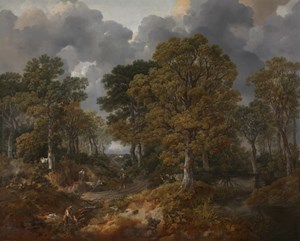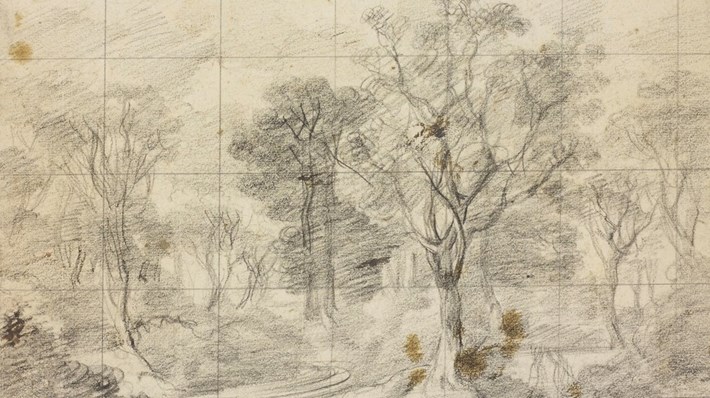
Twenty-five landscape drawings reattributed to Thomas Gainsborough (1727–88) will go on display for the first time in an exhibition in England and Ireland.
Twenty-five landscape drawings reattributed to Thomas Gainsborough (1727–88) will go on display for the first time in an exhibition Young Gainsborough: Rediscovered Landscape Drawings, travelling to York Art Gallery, the National Gallery of Ireland and Nottingham Castle in 2021 and 2022. Produced in the late 1740s when Gainsborough was in his early twenties, the drawings offer an intimate glimpse into the early career of one of Britain’s best-loved artists.
The drawings were previously believed to be by the painter Sir Edwin Landseer, having been acquired by Queen Victoria from his studio in 1874. They were then housed in the Print Room at Windsor Castle, bound in an album titled 'Sketches by Sir E Landseer'. In 2013, the art historian Lindsay Stainton identified one of the drawings as a study for Gainsborough’s most celebrated landscape painting, Cornard Wood (c.1748), leading to the reattribution of the drawings to Gainsborough. This discovery represents a major contribution to Gainsborough’s work as a draughtsman, and dramatically expands the number of known drawings from this early part of his career. To place the drawings in context, the exhibition will feature other paintings and drawings from Gainsborough’s early years. Visitors will gain an understanding of how Gainsborough made his drawings and experience the brilliance of his close attention to every detail in nature.
The youngest son of a cloth merchant from Sudbury, Thomas Gainsborough displayed artistic promise from a young age, and much of his youth was spent producing landscape views of his home county of Suffolk. He later excelled in the more fashionable and lucrative genre of portraiture, becoming a founding member of the Royal Academy and official court painter to George III, rivalled in prestige only by Sir Joshua Reynolds. Although portraiture brought Gainsborough wealth and fame, his preference for landscape remained a constant throughout his life. He famously wrote in the 1760s: ‘I’m sick of Portraits and wish very much to take my Viol da Gamba and walk off to some sweet Village where I can paint Landskips and enjoy the fag End of Life in quietness and ease.’

The study for Cornard Wood will hang alongside the finished painting, newly conserved and loaned by The National Gallery, London, uniting the painting with its preparatory drawing for the first time since they were last together in Gainsborough’s studio. The drawing offers a fresh glimpse into Gainsborough’s creative process. He ruled a squared grid over the preparatory drawing, a common technique that allowed an artist to transfer (and enlarge) a composition square by square from a study sheet onto a larger canvas. Numbers pencilled along the lower edge of the sheet allowed him to keep track of the transfer process, while traces of oil and paint suggest that he had the drawing close to hand while working on the painting in his studio. The now-famous painting depicts an area of woodland near Great Cornard, about two miles from Gainsborough’s childhood home. In contrast to his formal society portraits, which tended to depict landed gentry within their private estates, the subject here is common land, shown bustling with local people gathering wood and grazing animals. The richly coloured and affectionately painted scene reflects both Gainsborough’s observational skill and his deep love of the Suffolk countryside.
When conservators at Windsor Castle removed the drawings from their album in preparation for the exhibition, four of the sheets were discovered to have further drawings on the reverse, where Gainsborough used both sides of the paper to experiment with compositions. One is a small study of the head of a young woman, in the slightly naive figure style of Gainsborough’s early portraits. The sheet will be displayed double-sided in the exhibition, encapsulating the fluidity with which Gainsborough switched between - and often combined - portraiture and landscape as he sought to make his mark on the British art scene.
A section of the exhibition will explore the decisive formative influence that Dutch landscape painting had on the young Gainsborough, having been employed by an art dealer in London to restore and copy works by 17th-century artists such as Jacob van Ruisdael and Jan Wijnants. The shared features of the Netherlands and East Anglia – their flat fields punctuated with windmills and winding paths – enabled Gainsborough to incorporate Dutch motifs directly into his Suffolk landscapes. He admired the naturalistic approach of Dutch artists and emulated their depictions of brooding skies, dense foliage and fallen trees, evident in his Landscape with a Pool (c.1746-47), on loan from the Fitzwilliam Museum, Cambridge. Ruisdael’s A Pool surrounded by Trees, and Two Sportsmen coursing a Hare (c.1665), on loan from The National Gallery, London, clearly shows the influence that this artist had on Gainsborough’s approach to composition and detail.
The final section of the exhibition will consider Gainsborough’s drawing practice and use of materials. Most of the drawings are on coarse paper imported from France, usually used for wrapping and packing. This cheap paper presumably appealed to Gainsborough as its rough surface provided good friction for drawing in chalks, while its grey tone meant he could experiment with using both black and white. His chalks were held in a split-stick known as a porte-crayon and blended onto the paper using a wad of tightly rolled leather called a ‘stump’, to create subtle light effects and gradations in tone. By contrast, seven of the drawings are on a fine white artists’ paper, which came from the Netherlands, its smoother surface allowing for detailed foliage drawn in sharp black chalk, as seen in Trees beside a path winding into the distance (c.1748-50). Three of the drawings feature large brown oil stains, suggestive of an accident in the studio where a jar of linseed oil was knocked onto a pile of drawings.
Gainsborough often sketched outdoors, and pin holes visible in the corners of several drawings suggest that he pinned the paper to a portable drawing board. These open-air (plein air) sketches, such as Trees beside a descending path (c.1746-48) reveal Gainsborough’s drawing process, which began with outlining trees and foliage in black chalk, before working up more detail from the centre outwards. He also made observational studies of individual plants and animals, such as A study of a tree, possibly a sycamore (c.1746-48), which would later serve as stock motifs to be drawn upon when composing studio paintings. As the Morning Herald noted in its 1788 obituary of Gainsborough, ‘nature was his teacher and the woods of Suffolk his academy.’ The beauty and immediacy of these rediscovered drawings are testament to Gainsborough’s innate talent and his enduring love of landscape.

ArtDependence Magazine is an international magazine covering all spheres of contemporary art, as well as modern and classical art.
ArtDependence features the latest art news, highlighting interviews with today’s most influential artists, galleries, curators, collectors, fair directors and individuals at the axis of the arts.
The magazine also covers series of articles and reviews on critical art events, new publications and other foremost happenings in the art world.
If you would like to submit events or editorial content to ArtDependence Magazine, please feel free to reach the magazine via the contact page.